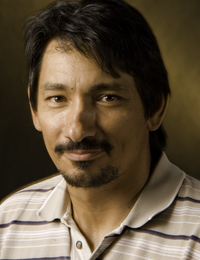
Edward Martínez
Las Vegas, NM –Highlands University professor Edward Martínez was tapped for a summer fellowship with the U.S. Department of Agriculture aimed at advancing excellence at Hispanic serving institutions and developing a well-prepared Hispanic workforce.
Martínez was also selected to participate in the new Undergraduate Visualization and Modeling Network (UVMN) program funded by the National Science Foundation to advance watershed science through cutting-edge 3-D visualization and modeling.
New Mexico EPSCoR — Experimental Program to Stimulate Research — administers the UVMN program, a consortium of New Mexico, Nevada and Idaho universities.
At Highlands, Martínez, a natural resource management professor, has a water quality laboratory. Much of his and his students’ research focuses on watershed locations like the Rio Mora National Wildlife Refuge and the Valles Caldera National Wilderness Preserve.
For the two-week USDA E. Kika de la Garza Fellowship Program, Martínez was selected from a national pool of faculty and professionals at Hispanic serving institutions, or HSIs.
“During the USDA fellowship, I’ll be learning more about funding opportunities for universities, some specifically for HSIs like Highlands,” Martínez said. “I’ll share the knowledge I gain about what the USDA has to offer with other Highlands faculty through a workshop.”
Martínez and the other fellows will meet with senior executives from USDA agencies such as the Natural Resource Conservation Service, U.S. Forest Service, and Agricultural Research Service to learn about research grants, as well as student internship and permanent employment opportunities.
He said the fellowship is part of an ongoing USDA effort to diversify its workforce.
“With a large percentage of USDA employees retiring within the next 5-to-10 years, there will be many employment opportunities under the USDA umbrella. A lot of students don’t realize that the USDA hires students majoring in many disciplines beyond those related to agricultural sciences, like human resources, accounting and engineering,” Martínez said.
Since 2006, Martínez has garnered a number of USDA grants that have benefited Highlands University students majoring in science, technology, engineering and math, collectively known as STEM.
Martínez’ Supporting Agriculture in Science and Education (SASE) grants funded summer research experiences at Highlands for students from New Mexico high schools from 2006 — 2013. Science faculty from different disciplines taught 140 SASE students over the years, successfully recruiting them for STEM majors.
From 2009 — 2011, the USDA also funded Martínez’ FRRRE grant — Focusing Recruitment, Retention and Research Experiences of underrepresented minorities in natural resource management.
Geology faculty Jennifer Lindline and Michael Petronis were co-principal investigators for the FRRRE grant.
“The USDA grant funding to date has been used successfully to support many STEM students at Highlands, resulting in increased retention and graduation rates,” Martínez said.
For the Undergraduate Visualization and Modeling Network program, Martínez and undergraduate geology major Ikhzaan Saleem were selected for the one-year training program.
“UVMN is a brand-new program developed in the recognition that modeling and visualization skills are critical in earth and environmental science,” said Mary Jo Daniel, associate director for New Mexico EPSCoR. “We’re using a novel approach by inviting faculty-student teams to attend as co-learners who will work collaboratively to create learning modules for existing courses at their home institutions.”
At Highlands, Martínez will use the learning modules in courses he teaches such as watershed management, water science, and limnology — the study of lakes and streams.
“Modeling technology is being used increasingly in scientific research. As professors, we need to learn 3-D modeling so we can teach our students — helping prepare them for careers and graduate school,” Martínez said.
Martínez and Saleem will learn Google Earth open-source software to develop 3-D watershed models and create the teaching modules.
“This software will provide an easier, more efficient and precise way to collect data and generate 3-D models,” Martínez said. “One application might be creating contour maps of Peterson Reservoir in Las Vegas to calculate volume of water and sedimentation.
“I believe this training will allow me to model the entire watershed at Rio Mora and incorporate this with data I’m already collecting, making it possible to make connections between water quality data and changes in landscape occurring from climate change or human impacts,” Martínez said.
New Mexico EPSCoR has worked since 2009 to build the state’s capacity to conduct scientific research. In the same year, Martínez garnered a $631,548 EPSCoR grant for Highlands to support faculty and student research, including purchasing new research instrumentation.
Since then, the university was awarded a number of $50,000 EPSCoR seed grants.
“Dr. Edward Martínez has played a strong leadership role in administering the initial EPSCoR grant, and involving his colleagues at Highlands,” Daniel said. “I’m very impressed with the Highlands science faculty, including the energy, expertise and commitment they demonstrate in providing research opportunities for their students.”
Martínez is a Mora, New Mexico, native who earned his B.S. in environmental science from Highlands and completed his Ph.D. in environmental and natural resource sciences from Washington State University. He joined the Highlands faculty in 2005.
